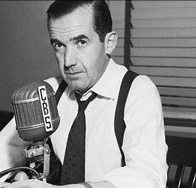 A lot has changed in the 50 years since Edward R. Murrow made his now-famous speech challenging television news to live up to its potential. What’s sad is how much is still the same.
A lot has changed in the 50 years since Edward R. Murrow made his now-famous speech challenging television news to live up to its potential. What’s sad is how much is still the same.
Murrow’s keynote address to the Radio-Television News Directors Association in Chicago half a century ago this month was deliberately provocative. When he accepted the invitation he told the organizers, “Somebody ought to make a speech on one of those occasions which would outrage all of our employers.” So the best known, most respected broadcast journalist of his day stood up and did it, knowing he’d be accused of “fouling his own comfortable nest.”
“This instrument can teach, it can illuminate; yes, and even it can inspire,” he told the audience. “But it can do so only to the extent that humans are determined to use it to those ends. Otherwise, it’s nothing but wires and lights in a box.”
Murrow “was disgusted with what he saw on prime time,” says former CBS News Vice President Bill Small, who was program chairman for the 1958 convention. “It was crap, and it hasn’t changed in 50 years.”
In his speech, Murrow denounced “the constant striving to reach the largest possible audience for everything,” including news programs, and the pressure to make bigger and bigger profits. Since then, it’s only worsened. Imagine what Murrow would think about product placements in local news programs, like the McDonald’s cups on the set of a Las Vegas station. Imagine how he’d react to prime time news magazines like CBS’ “48 Hours Mystery” or “Dateline NBC” with its “To Catch a Predator” feature.
“I think he would say everything he predicted [about the three networks] has come true, and he would be very depressed,” said Stan Cloud, during the panel discussion “What Would Murrow Do?” at this year’s RTNDA conference. Cloud is the author of “The Murrow Boys: Pioneers on the Front Lines of Broadcast Journalism.” “But if you talk about online, cable, I think he would say the opportunity is still there to teach, to inspire, but we’re still not doing it.”
The man now known as the patron saint of broadcast journalism wasn’t all high church himself, of course. Don Hewitt, who created “60 Minutes,” calls that program a blend of “high Murrow and low Murrow” – the serious documentaries of his 1950s shows “See It Now” and the soft interviews of “Person to Person.”
“Ed always figured it was all right to look in Marilyn Monroe’s closet if you were also willing to look in Robert Oppenheimer’s laboratory,” Hewitt told a forum at the National Press Club in 2006. But that balance is gone. Today, it’s all about celebrities’ closets. A nuclear physicist would have to be found hiding in one to have a chance of getting on the air.
So where would Murrow fit in today’s broadcast news world? He wouldn’t, says XM Radio’s Bob Edwards, who wrote “Edward R. Murrow and the Birth of Broadcast Journalism.” “I see him churning out podcasts and a lively blog.”
“He would have abandoned the networks,” says Marci Burdick, senior vice president of the media firm Schurz Communications. “He would have his own show on the History Channel or Discovery or PBS and a Web site for investigations.”
Broadcast journalists have been playing the “what would Murrow do” parlor game a lot this year, which marks not only the 50th anniversary of his RTNDA speech but also the 100th anniversary of his birth. Murrow was both an inspiration and a model, and he still has lessons to teach.
Many of today’s reporters could use more of the courage, integrity and steadiness that were hallmarks of Murrow’s work. Some over-the-top, self-important anchors should take this Murrow admonition to heart: “The fact that your voice is amplified to the degree where it reaches from one end of the country to the other does not confer upon you greater wisdom or understanding than you possessed when your voice reached only from one end of the bar to the other.”
If nothing else, it would be heartening to hear more scripts like Murrow’s – simple, clear and memorable. Listen to his radio reports from World War II and you won’t hear any of the hype or “journalese” that infects so much broadcast writing today. He used alliteration and analogies sparingly but effectively, not just to be clever. In London during the Blitz: “The blackout stretches from Birmingham to Bethlehem, but tonight, over Britain, the skies are clear.” Of the liberated prisoners at the Buchenwald death camp, he wrote: “It sounded like the handclapping of babies, they were so weak.”
At CBS headquarters in New York, a plaque dedicated to Murrow reads, “He set standards of excellence that remain unsurpassed.” True enough, but also a little depressing. Murrow, immortalized in the 2005 film “Good Night and Good Luck,” died more than 40 years ago, and no one has yet replaced him in the pantheon of broadcast journalism greats.
David Halberstam once wrote that Murrow was “one of those rare legendary figures who was as good as his myth.” If only his influence were as widespread as his reputation.
Originally published in American Journalism Review, October-November 2008








